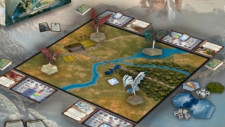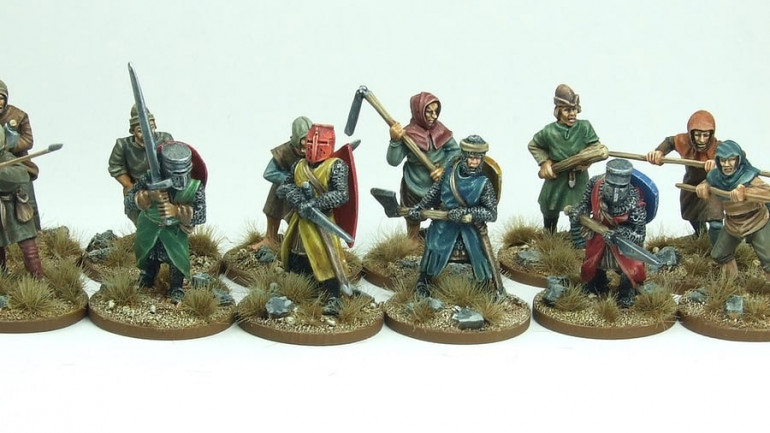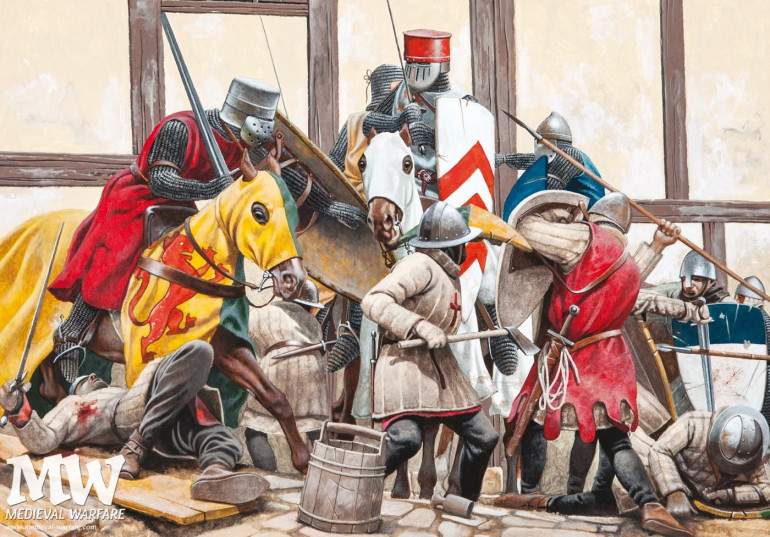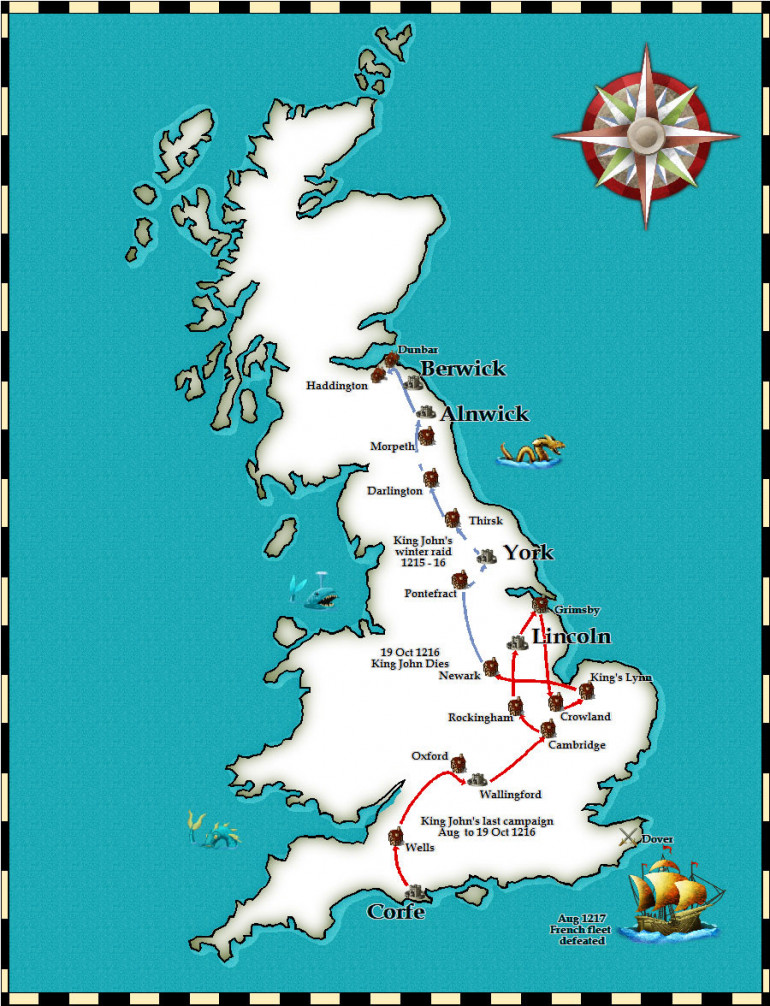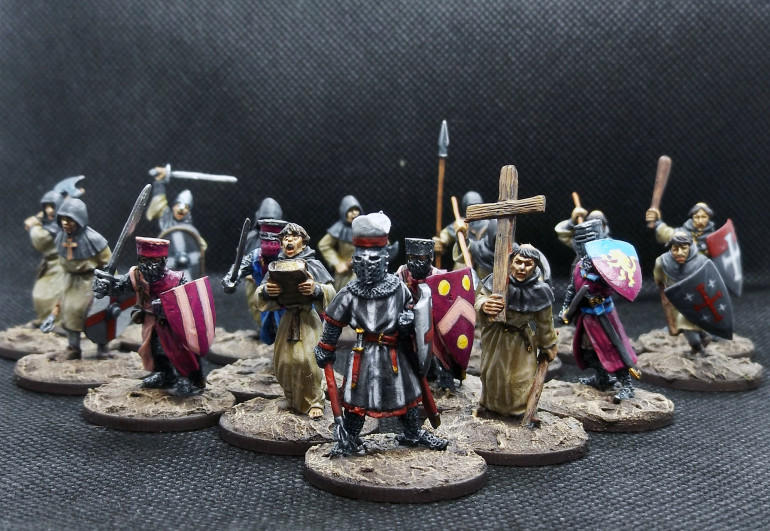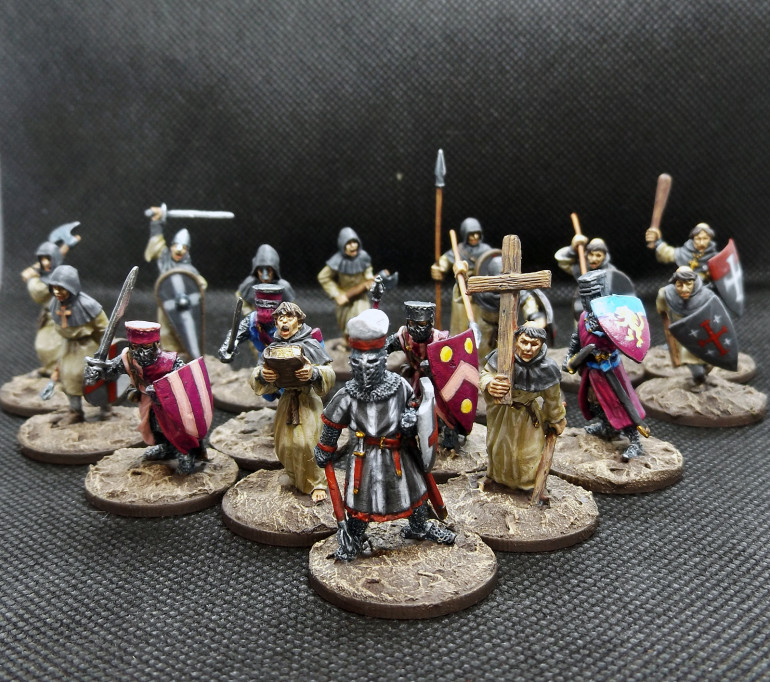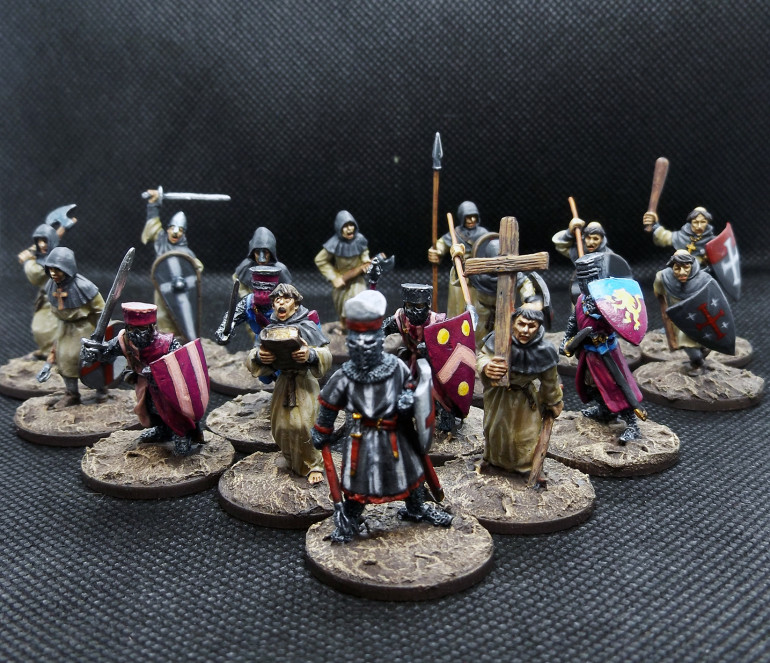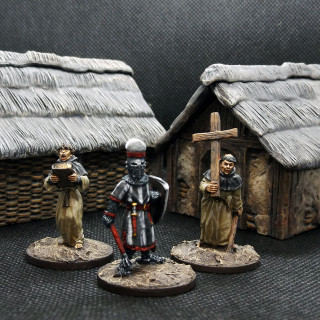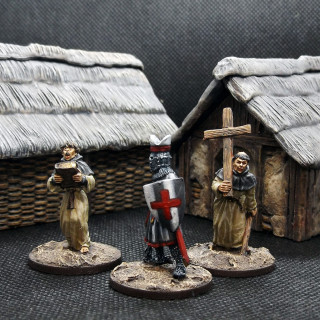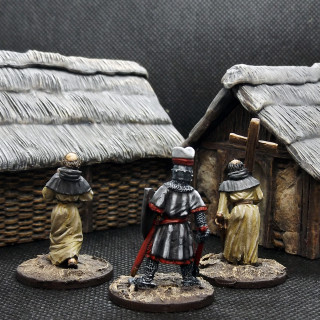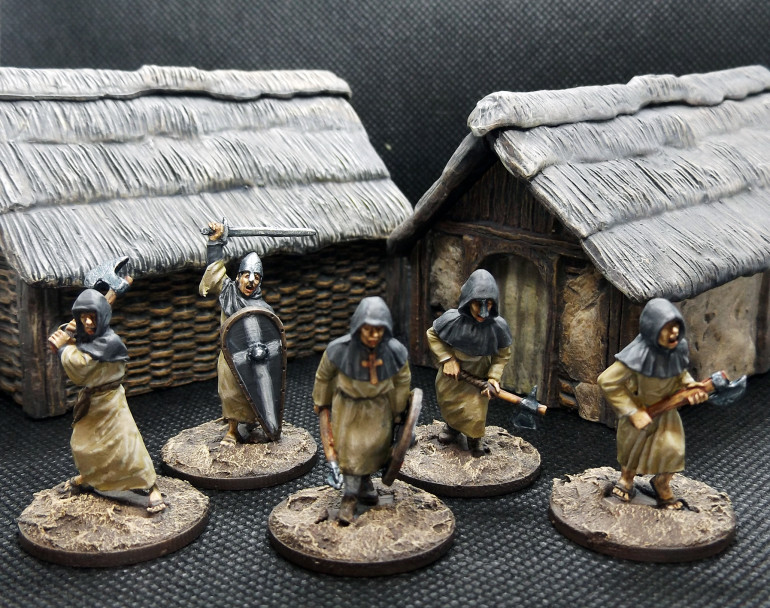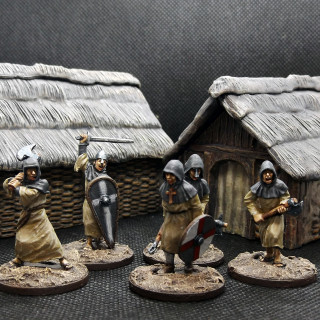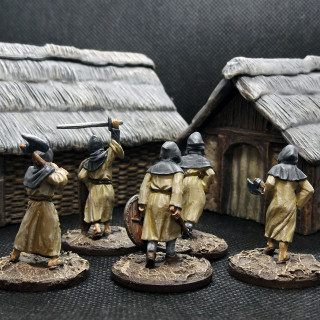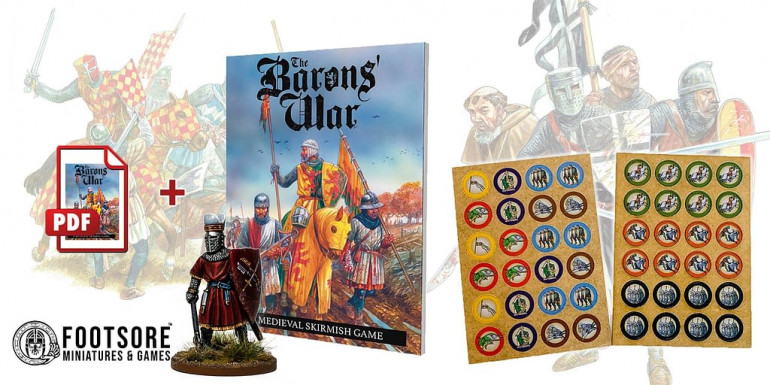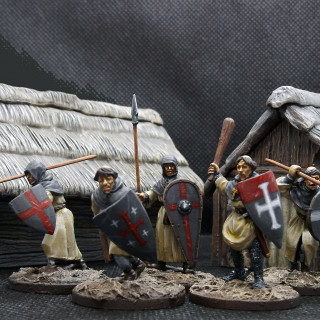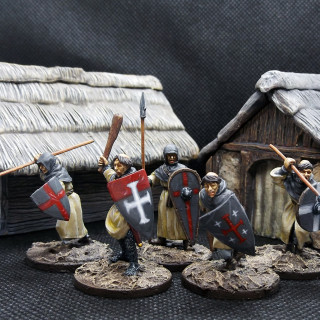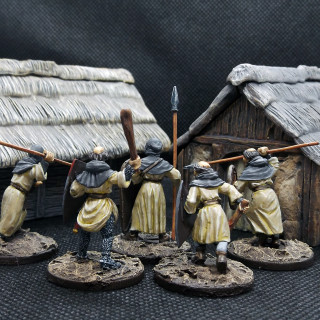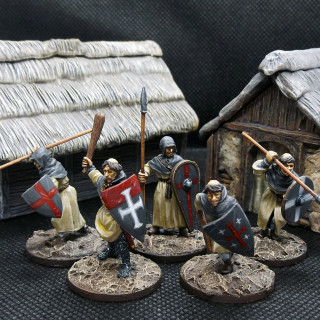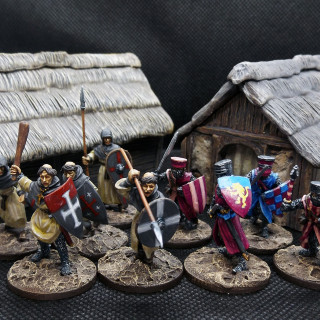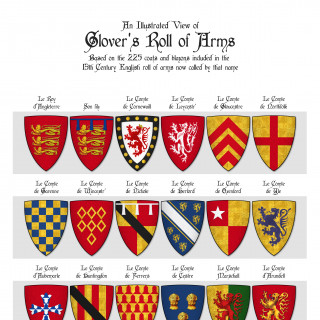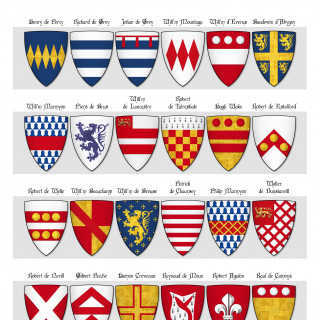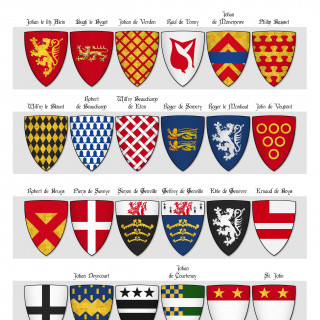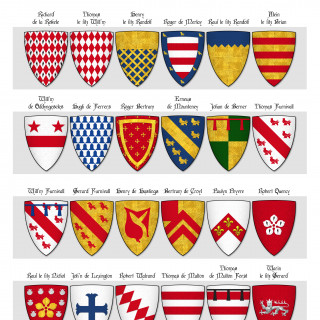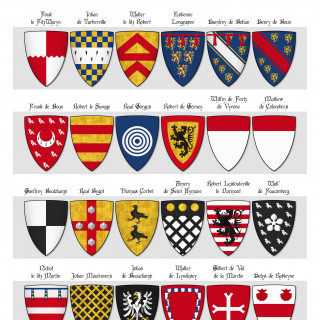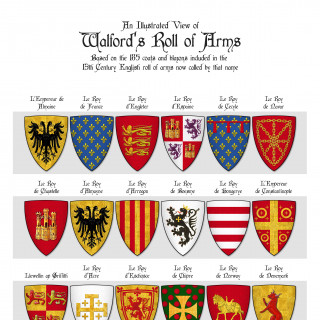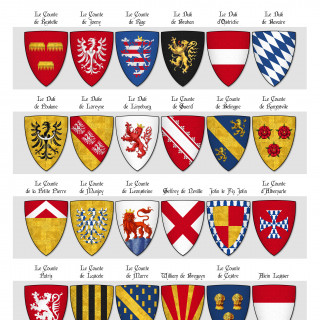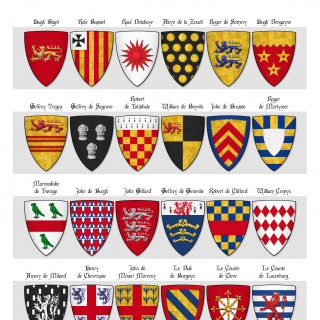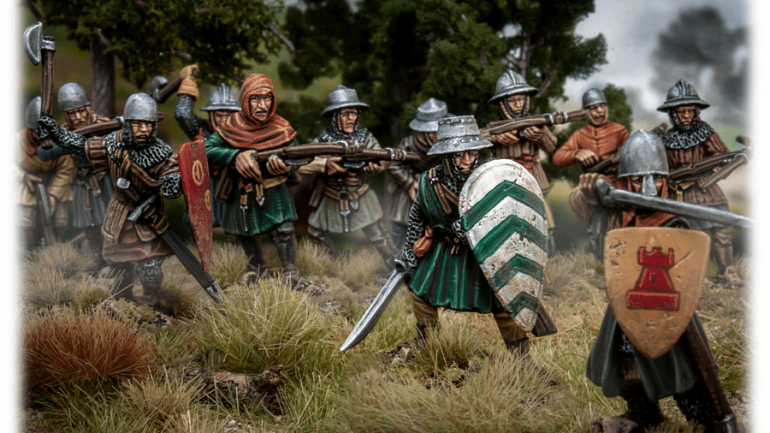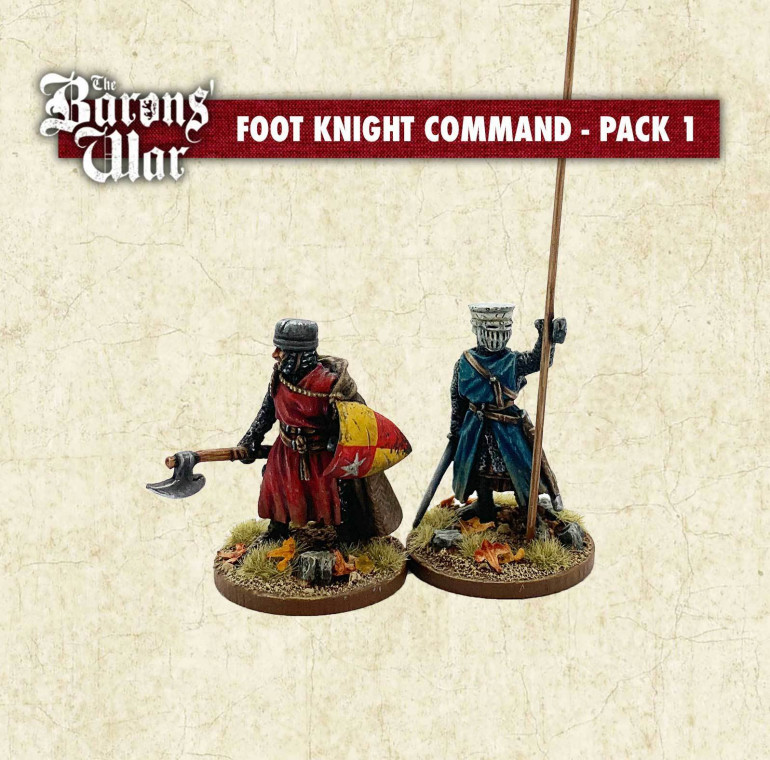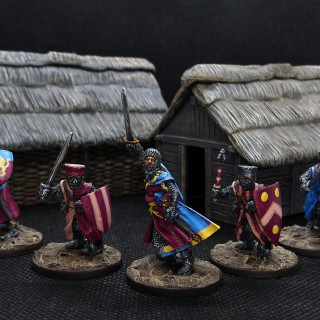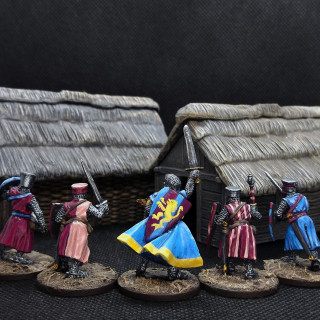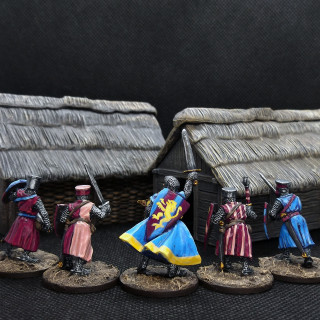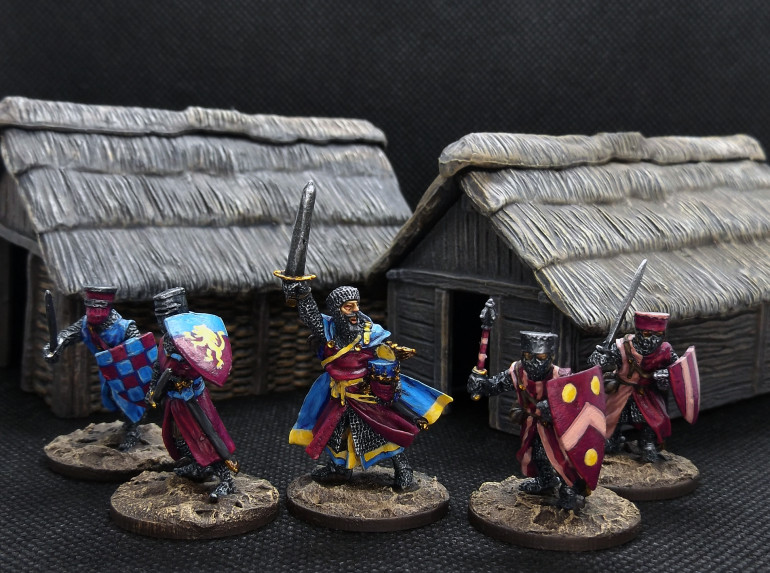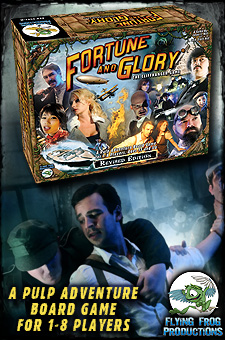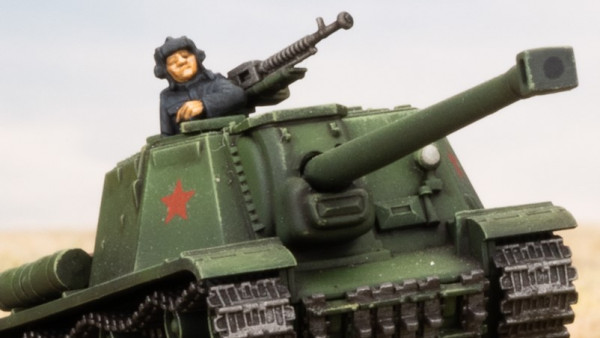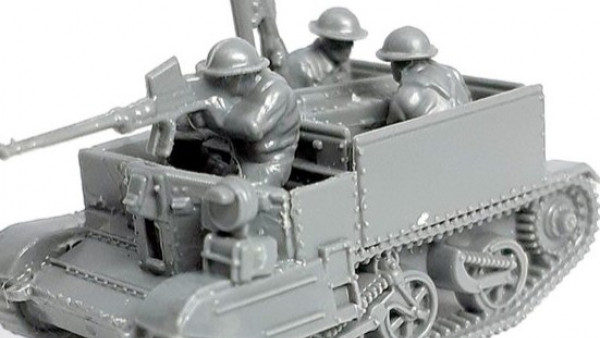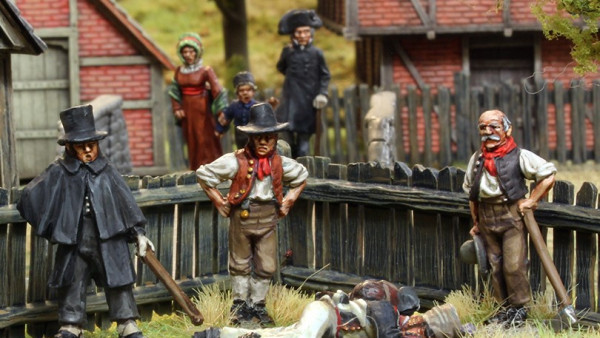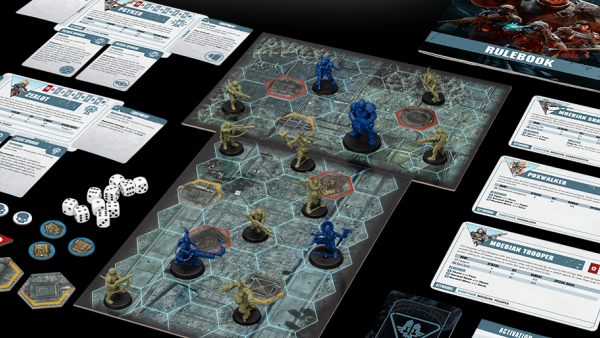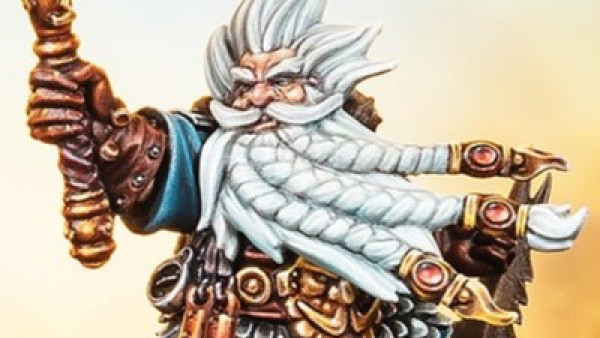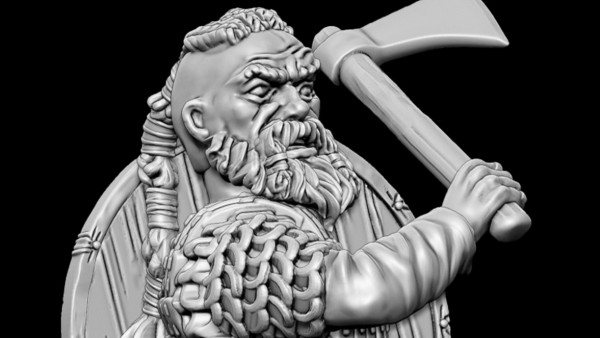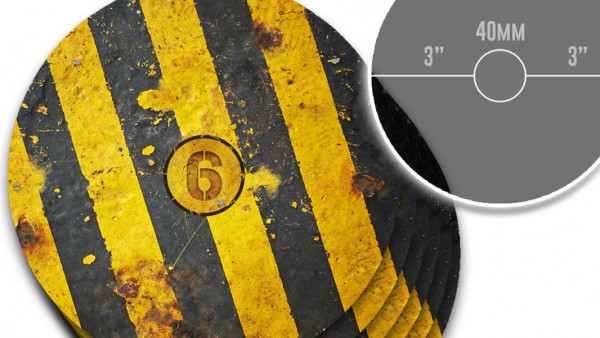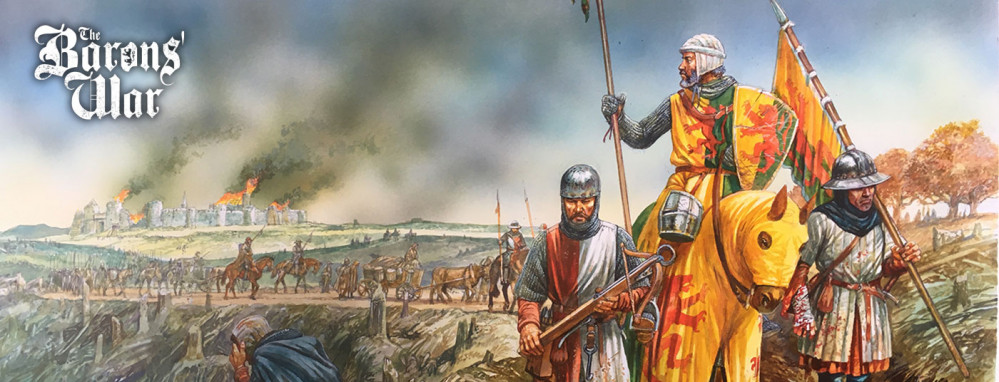
PanzerKaput Goes To Barons’ War
Recommendations: 11323
About the Project
Set against a backdrop of a Civil War that lasted for two years, 1215-17, as a result of the issuing of Magna Carta. A civil war was the perfect opportunity for the leading nobles of the time to grab land and power while settling some old scores along the way. This vying for land and power hadn't stopped since the invasion of 1066 with only the strongest of kings being able to keep their nobles in check. Our narrative focuses on small groups of warriors brought together under a lord or baron to raid and steal or defend land and property. With the strong, wise, cunning and lucky aiming to rise out of this civil strife in a better position than when it started. The Barons' War skirmish game has been written to enable players to fight out tabletop battles against the backdrop of the First Barons’ War between rival Barons or rival factions who find themselves on either side of the conflict. The game is historically themed, the gameplay is fast-paced and tactical with plenty of narrative and where force building presents you with lots of options enabling two players to muster very different retinues. However, as intended, this is an alpha set of rules which does not include rules for siege warfare, although rules for fighting in buildings are included. Campaign rules are something that will be addressed at a later date and released online. Having grown out of the Barons’ War Kickstarter project, the intention is for this ruleset to develop into a system that could be used throughout the Medieval period. Starting with England from when the Western Roman Empire withdrew around 410 AD to 1485 AD when Richard III died at the Battle of Bosworth Field. This presents us with a huge span of history for gaming which can be broadly divided into Romano-British, Anglo-Saxon and Viking, Anglo-Norman, Angevin and Plantagenet. And that’s just when looking at it from Great Britain. With warriors of this period being pretty similar, it would be easy to use the profiles in this rulebook to play out tabletop battles in any setting. Over time we see these rules evolving with additional warriors, characters, abilities and scenarios being added starting with the Dark Ages, the Anarchy and the Crusades and shared to www.warhost.online, which has been set up to be the community website for the game.
Related Game: The Barons' War
Related Company: Footsore Miniatures and Games
Related Genre: Historical
This Project is Active
Battles of Magna Carta, Part Two
1215: THE SIEGE OF EXETER CASTLE
The dissent of the Barons now takes centre stage in what is now Exeter, far to the South-West of Rochester. Rougemont Castle is also known as Exeter Castle, and is a Norman structure, with some Roman origins. It was a Crown stronghold, but rebel barons captured it for a time.
1215: THE SIEGE OF TONBRIDGE CASTLE
Tonbridge Castle was enlarged before 1100, with a squat tower. In 1215 Richard FitzGilbert’s grandson, Richard de Clare, attended the sealing of Magna Carta. King John then attacked and seized the castle, but it was returned two years later. A larger stone castle was rebuilt, including the massive gatehouse which still survives.
1215: THE SACKING OF ELY CASTLE
In the relentless drive northwards by King John, many fortified sites were attacked. Ely castle was said to be ‘a strong fort of lime and stone’, within the precincts of Ely, but ‘that fort being often destroyed’ was rebuilt. The castle was said to have been finally taken and destroyed by Falk de Breauté, in 1216.
1216: THE SIEGE OF ODIHAM
Odiham had been a royal residence in the 12th century, but the present castle, built by King John from 1207 onwards, was built on a site to the North-West of the town. It was built for the King to enjoy hunting in Odiham’s Royal Deer Park. John visited on 4th June and then again on 9th June, meeting the Bishop of Winchester and proceeding to Windsor and Runnymede the following day. Following the sealing of Magna Carta King John stopped the night of 26th June at Odiham on his way to Winchester. Odiham Castle put up stout resistance to a French siege the following year, which inflicted so much damage as to need rebuilding, with the octagonal keep. These efforts supported the defence of Windsor Castle and help to ensure the French siege was repulsed there as well.
Battles of Magna Carta, Part One
1214: THE BATTLE OF BOUVINES.
The Battle of Bouvines, near Lille, took place on 27 July. King Philip II defeated the Holy Roman Emperor, Otto IV, conquering Flanders and the Angevin territories in France, and recovering lands once ruled by King John. No English forces were involved. John was Otto’s uncle, and the decisive defeat led to the English Barons gaining the confidence to confront the king and make him grant the Great Charter.
1215: THE SIEGE OF NORTHAMPTON CASTLE.
Northampton marked the beginning of the Barons’ Wars, but the rebels failed to capture the castle. It was the first of three sieges. King John was fond of the castle, and visited it over 30 times, but later gave it up along with three others in granting Magna Carta. In 1164, it was the site of the trial of Thomas à Becket. Early Parliaments were held there until 1331.
1215: THE SIEGE OF NORHAM CASTLE
Norham Castle was a mighty English stronghold on a rocky outcrop on the south bank of the River Tweed. Now a ruin, it was built by Bishop Flambard of Durham in 1121, and being just half the river’s width away from the English and Scottish border, earned it the title of ‘the most dangerous place in England’. King John strengthened the castle from 1208 to 1212, and this helped it withstand a 40-day siege by Alexander II of Scotland, who had invaded northern England in support of the rebels in 1215.
1215: THE SIEGE OF ROCHESTER CASTLE
In 1215, Rochester Castle was garrisoned by rebel barons, and endured an epic siege by King John. Having undermined the outer wall, John used the fat of 40 pigs to fire a mine under the keep, bringing its southern corner crashing down. The defenders held on, until they were eventually starved out after resisting for two months. The soldiers were put to the sword. The high elegant towers of Rochester Castle stand as a testimony to its history of destruction and rebuild.
Episode Events
1214
Oct 15
John returns from France
Upset by demands for higher taxes and less control over affairs in England, the Barons met John on his return with a charter from the time of Henry I which they wanted John to agree to and abide by.
Nov 20
Charter of Liberties
A group of barons, after finding a copy of King Henry I’s Charter of Liberties, swore an oath at the altar of t. Edmunds at Bury St. Edmunds to force King John to acknowledge thier rights.
1215
Jan
John meets the Barons in London
Promising the Barons safe passage, John met them in London to discuss their demands. John postponed any answer until Easter.
May 17
London falls to the Rebels
The gates to London were opened by a supporter of the rebellious Barons and the houses of Jews were targeted for ransacking and burning. The rebels called for those Barons still on the side of John to join them. The Tower of London held by John’s supporters was too well defended to fall into the hands of the rebels.
May 27
A truce is sought
Stephen Langton and William Marshall attempted to get the Barons and John to meet and find a settlement to the civil war.
Jun 15
John’s Great Charter (the Magna Carta)
A large number of barons, led by Stephen Langton the archbishop of Canterbury, meet King John on an island in the Thames at Runnymede. They forced the king to sign the ‘Great Charter’ or Magna Carta that would limit the power of the monarchy. The barons insisted that the old feudal contract should be reinstated and that the king should abide by the laws that the rest of the population did. The feudal contract allowed the barons to run their own lands, renting it from the king but paying rent by supplying knights rather than money. This feudal system had been set up by William the Conqueror.
Aug 24
The Magna Carta is annulled
Pope Innocent III annulled the Magna Carta freeing King John from its limitations. The Pope annulled the charter on the grounds that the King only signed it because he was forced to and that the document was illegal. The Pope was prepared to support John against the rebel barons because he wanted him to take a key role in a new crusade.
Sep 13
King John appeals to the Pope
In a letter dated 13th September 1215, King John sought help from Pope Innocent III in his fight against the barons. In the letter, written while the King stayed at Dover Castle, John stated that he believed the defence of England was ultimately the responsibility of God and the Pope. Pope Innocent III agreed and declared that the Magna Carta should be annulled.
Oct (to 1217)
Baron’s war
After the Magna Carta was annulled and it was clear that King John was not going to agree to the terms of the charter the civil war between King John and the rebel barons began. The barons offered the English crown to Prince Louis, the son of King Philippe II of France and invited him to invade England. John confiscated the rebel barons’ lands and gave them to his own supporters. King John besieged Rochester Castle where a garrison of men had been left by the barons. The garrison was starved out and the castle fell to the King.
1216
Jan
King John attacks Berwick
King John attacked Berwick and forced the Scots to leave. He also raided the lowlands.
Feb
King John puts down revolt
King John put down a revolt in East Anglia. The Barons and the French kept hold of London.
Feb
Small French fleet land in London
A small French army landed in London. Their commander informed the rebel barons that Prince Louis would soon arrive from France.
May 18
A storm hits John’s fleet
John’s fleet of ships was badly damaged by storms as they prepare to defend against an invasion from France. This left the way open for Prince Louis to sail to England a few days later.
May 21
Prince Louis of France claims English Throne
Invited by the barons opposed to king John, Prince Louis of France landed in England to claim the English Throne. Louis captured Rochester Castle after a short siege.
Jun (to Oct)
Prince Louis advances across England
Prince Louis advanced on Winchester and captured the city and its castle. Elsewhere, Windsor Castle and Dover Castle were besieged by the rebel barons. Both castles were defended and held out against the sieges. King John used Corfe Castle in the south-west as his base of operations while he planned his campaign against the rebel barons and Prince Louis.
Oct 19
King John dies
King John died at Newark. This was shortly after he lost his baggage train in the Wash estuary as the tide returned. There was supposed to be a large amount of treasure in the baggage train at the time and it has never been found.
Oct 28
King Henry III Crowned
King John’s eldest son Henry was crowned King Henry III at the abbey church of Gloucester by Peter des Roches the Bishop of Winchester. The Earl of Pembroke, Earl Marshal of England (William Marshal), was declared Regent.
1217
Spring
Portchester castle captured
Prince Louis captured and almost destroyed the castle at Portchester.
Apr
Siege of Mountsorrel Castle
Royalists besieged the French controlled Mountsorrel Castle in Lincolnshire. When Louis sent reinforcements to assist those in the castle the royalists moved away to Nottingham. The French army then made the mistake of moving on to Lincoln where the royalists had held out against previous attacks.
May 20
Battle of Lincoln
Henry III’s supporters defeated the forces belonging to Prince Louis and the rebel barons that were besieging the castle at Lincoln.
Aug 24
Battle off Sandwich
A fleet of French ships were defeated off the coast near Sandwich by Hubert de Burgh. The French fleet was commanded by Eustace the Monk, a pirate and mercenary who fought for both the French and English when it suited his needs. The French fleet were bringing more men and supplies to assist Prince Louis in his quest to take the English throne. The ship Eustace was on was captured and the monk was executed.
Sep 12
Treaty of Kingston
The defeat of the French fleet left Prince Louis without much hope of taking the English throne. William Marshall blockaded London from the sea and land and at Lambeth Louis accepted peace terms. Louis waived his claim to the throne of England and should have restored Normandy to Henry but did not. Louis was paid 10,000 marks to ensure he left the country as soon as possible. William Marshall pardoned all those who had supported Louis. low profile.
The Barons' Wars 1215-1217 Simple Version
The First Barons’ War was fought 1215 until 1217.
Cause of the war was King John’s refusal to act according to what he had agreed upon by signing the Magna Carta.
Controversy
Some may say Magna Carta was not voluntarily agreed upon by John and some clauses were outright unrealistic; that John had the barons up to the ears, and simply signed to get them off his back.
The First Barons' War Ensues
In any event, John refused to co-operate and the French sent over some knights to support the barons and their demands. The French found the timing perfect for Louis VIII, son of King Philip II of France, to rule England instead of John.
In 1216, Louis landed in Kent. John fled and Louis was proclaimed king.
Turning Point of the First Barons' War
In October 1216, King John died. Public opinion preferred John’s son Henry III as king rather than French Louis VIII. Many barons felt the same way. Thus, John’s son Henry III became king in 1216 when he was nine years old. Louis VIII was not welcome to rule anymore.
New king Henry III later re-issued a revised Magna Carta, first in 1225 and again in 1264.
One of the decisive battles of the First Barons’ War was the Battle at Lincoln on May 20, 1217. The barons were defeated and Louis had to agree to the Treaty of Kingston-upon-Thames of September 12, 1217. The treaty granted amnesty for the rebels and Louis had to promise to keep a low profile.
All the Milites Christi and Command
This is the sum total of the painted force for the St Mary de Pratis so far. There is a couple more units to add and then this will be the first force completed.
Abbot William Pepyn
This is the leader and command section, a priest and standard bearer, for me St Mary de Pratis force. William Pepyn was the Abbot from 1205 to 1222 and in their is no evidence that he was a militant Abbey or a warrior but lets not reality stand in the way of a good game.
I have painted him is same colours as the Monks but have made them brighter to reflex his status.
The Second Militant Monk Unit
This is the second unit of Milites Christi finished for my St Mary de Pratis force. As you can see these monks are more militant than the first unit with there double handed axes to been the word of God to the faithless. Again I have based these on the Black Canons of Leicester Abbey, an Augustinian order.
The Barons' War Rules
In the Kingdom of England by 1215, a group of powerful barons had reached breaking point due to King Johns despotic rule, high taxes and failed leadership. It was time to rebel!
Written by Andy Hobday, creator of The Barons’ War, co-developed Test of Honour and Mortal Gods & Mortal Gods Mythic., and a bit of a geek., these rules enable narrative-driven tabletop games set in an England gripped by civil war played out against the backdrop of the Magna Carta and the invasion by the Crown Prince of France.
The historically themed gameplay is fast-paced and tactical. With warriors of this period being pretty similar, it is easy to base your medieval skirmish games using these rules in any setting.
This comprehensive flick through video by Wargames Illustrated takes you through the rulebook section by section presenting a clear overview.
First unit for the Milites Christi
I have finished my first unit if Militant Monks from the Abbey of St Mary de Pratis, Leicester Abbey for The Barons’ War: from Warhost and Footsore Miniatures & Games. These are known as the Black Canons because of their grab, as they are Augustinians and wear white habits and black hoods. I have gone are the more natural wool colours for these.
Roll of Arms
A roll of arms (or armorial) is a collection of coats of arms, usually consisting of rows of painted pictures of shields, each shield accompanied by the name of the person bearing the arms.
The oldest extant armorials date to the mid 13th century, and armorial manuscripts continued to be produced throughout the Early Modern period. Siebmachers Wappenbuch of 1605 was an early instance of a printed armorial. Medieval armorials usually include a few hundred coats of arms, in the late medieval period sometimes up to some 2,000. In the early modern period, the larger armorials develop into encyclopedic projects, with the Armorial général de France (1696), commissioned by Louis XIV of France, listing more than 125,000 coats of arms. In the modern period, the tradition develops into projects of heraldic dictionaries edited in multiple volumes, such as the Dictionary of British Arms in four volumes (1926–2009), or J. Siebmacher’s großes Wappenbuch in seven volumes (1854–1967).
Armorials can be “occasional”, relating to a specific event such as a tournament; “institutional”, associated with foundations, such as that of an order of chivalry, “regional”, collecting the arms of the nobility of a given region, “illustrative”, in the context of a specific narrative or chronicle, or “general”, with the aim of an encyclopedic collection. A roll of arms arranged systematically by design, with coats featuring the same principal elements (geometrical ordinaries and charges) grouped together as a tool to aid identification, is known as an ordinary of arms (or simply as an ordinary).
Glover's Roll
Glover’s Roll is an English roll of arms from the 1240s or 1250s, containing 55 coats of arms
The Matthew Paris Shields
The Matthew Paris Shields, not truly a roll but a set of marginal illustrations accompanying the chronicler’s illuminated manuscript works, Chronica Majora and Historia Anglorum. These date from c.1244–59, during the reign of Henry III, and contain drawings of shields with Latin annotations.
Walford's Roll
Walford’s Roll is an English roll dating from c. 1275, containing 185 coats with blazons.
The History of the Barons' War
The First Barons’ War (1215–1217) was a civil war in the Kingdom of England in which a group of rebellious major landowners (commonly referred to as barons) led by Robert Fitzwalter waged war against King John of England. The conflict resulted from King John’s disastrous wars against King Philip II of France, which led to the collapse of the Angevin Empire, and John’s subsequent refusal to accept and abide by “Magna Carta“, which he had sealed on 15 June 1215.
The rebellious barons, faced with an uncompromising king, turned to King Philip’s son, Prince Louis, who then sailed to England with an army despite his father’s disapproval, as well as the Pope’s, who subsequently excommunicated him. Louis captured Winchester and soon controlled over half of the English kingdom. He was proclaimed “King of England” in London by the barons, although never actually crowned.
Louis’ ambitions of ruling England faced a major setback in October 1216 when King John’s death led to the rebellious barons deserting him in favour of John’s nine year-old son, Henry III of England and the war dragged on. Louis’ army was finally beaten at the Battle of Lincoln on 20 May 1217. And after a fleet assembled by his wife Blanche of Castile, attempting to bring him French reinforcements, was defeated off the coast of Sandwich on 24 August 1217, he was forced to make peace on English terms. He signed the Treaty of Lambeth and surrendered the few remaining castles he held. The effect of the treaty was that Prince Louis agreed he had never been the legitimate king of England. This formalised the end of the civil war and the departure of the French from England.
The Background
King John in June 1215 was forced to put his seal to “The Articles of the Barons” by a group of powerful barons who could no longer stand John’s failed leadership and despotic rule. The king’s Great Seal was attached to it on 15 June 1215. In return, the barons renewed their oaths of fealty to King John on 19 July 1215. A formal document to record the agreement was created by the royal chancery on 15 July: this was the original Magna Carta. “The law of the land” is one of the great watchwords of Magna Carta, standing in opposition to the king’s mere will.
The Magna Carta of 1215 contained clauses which in theory noticeably reduced the power of the king, such as clause 61, the “security clause”. This clause allowed a group of 25 barons to override the king at any time by way of force, a medieval legal process called distraint that was normal in feudal relationships but had never been applied to a king. After a few months of half-hearted attempts to negotiate in the summer of 1215, open warfare broke out between the rebel barons and the king and his supporters.
Course of events
French intervention
The war began over Magna Carta but quickly turned into a dynastic war for the throne of England. The rebel barons, faced with a powerful king, turned to Louis, son and heir apparent of King Philip II of France and grandson-in-law of King Henry II of England. The Norman invasion had occurred only 149 years before, and the relationship between England and France was not so simply adversarial as it later became. The contemporary document called the annals of Waverley sees no contradiction in stating that Louis was invited to invade in order to “prevent the realm being pillaged by aliens.”
At first, in November 1215, Louis simply sent the barons a contingent of knights to protect London. However, even at that stage he also agreed to an open invasion, despite discouragement from his father and from Pope Innocent III. This came in May 1216, when watchmen on the coast of Thanet detected sails on the horizon, and on the next day, the King of England and his armies saw Louis’s troops disembark on the coast of Kent.
John decided to escape to the Saxon capital of Winchester, and so Louis had little resistance on his march to London. He entered London, also with little resistance, and was openly received by the rebel barons and citizens of London and proclaimed (though not crowned) king at St Paul’s Cathedral. Many nobles gathered to give homage to him, including Alexander II of Scotland, who held fiefs in England.
Many of John’s supporters, sensing a tide of change, moved to support the barons. Gerald of Wales remarked: “The madness of slavery is over, the time of liberty has been granted, English necks are free from the yoke.”
In pursuit of John, Louis led his army south from London on 6 June, arriving the following day in Reigate where he found the castle abandoned. He moved onwards to Guildford Castle on 8 June, which surrendered immediately. Farnham Castle initially closed its gates, but then it too surrendered as the French started to lay siege. He only met resistance when he reached Winchester Castle on 14 June – it fell after a ten day siege. Louis’ campaign continued and by July about a third of England was under his control.
First siege of Dover
In the meantime, the King of France taunted his son for trying to conquer England without first seizing its key port: Dover. The royal castles at Canterbury and Rochester, their towns, and indeed, most of Kent had already fallen to Louis but when he did move on to Dover Castle on 25 July it was prepared. Its constable, Hubert de Burgh, had a well-supplied garrison of men.
The first siege began on 19 July, with Louis taking the high ground to the north of the castle. His men successfully undermined the barbican and attempted to topple the castle gate, but De Burgh’s men managed to repel the invaders, blocking the breach in the walls with giant timbers. (After the siege the weak northern gate was blocked and tunnels were built in that area, to St John’s Tower, and the new Constable’s Gate and Fitzwilliam’s Gate.) In the meantime Louis’s occupation of Kent was being undermined by a guerrilla force of Wealden archers raised and led by William of Cassingham.
After three months spent besieging the castle, and with a large part of his forces diverted by the siege, Louis called a truce on 14 October and soon after returned to London.
Sieges of Windsor and Rochester
Apart from Dover, the only castle to hold out against Louis was that at Windsor, where 60 loyalist knights survived a two-month siege, despite severe damage to the structure of its lower ward (immediately repaired in 1216 by Henry III, who further strengthened the defences with the construction of the western curtain wall, much of which survives today). This is possibly due to its having been already besieged by the barons in 1189, less than 30 years earlier.
In 1206, John had spent £115 on repairs to Rochester Castle, and he had even preemptively held it during the year of the negotiations leading up to Magna Carta, but the Charter’s terms had forced him to hand it back into the custody of Stephen Langton, Archbishop of Canterbury, in May 1215. The rebel barons had then sent troops under William d’Aubigny to the castle, to whom its constable Reginald de Cornhill opened the castle’s gates. Thus, during October 1215 on his marching from Dover to London, John found Rochester in his way and on 11 October began besieging it in person.
The rebels were expecting reinforcements from London but John sent fire ships out to burn their route in, the city’s bridge over the Medway. Robert Fitzwalter rode out to stop the king, fighting his way onto the bridge but eventually being beaten back into the castle. John also sacked the cathedral, took anything of value and stabled his horses in it, all as a slight to Langton. Orders were then sent to the men of Canterbury.
Five siege engines were then erected and work carried out to undermine the curtain wall. By one of these means the king’s forces entered and held the bailey in early November, and began attempting the same tactics against the keep, including undermining the south-east tower. The mine-roof was supported by wooden props, which were then set alight using pig-fat. On 25 November 1215 John had sent a writ to the justiciars saying “Send to us with all speed by day and night, forty of the fattest pigs of the sort least good for eating so that we may bring fire beneath the castle”. The fire thus created caused one entire corner of the keep to collapse. The rebels withdrew behind the keep’s cross-wall but still managed to hold out. A few were allowed to leave the castle but on John’s orders had their hands and feet lopped off as an example.
Winter was now setting in, and the castle was taken on 30 November by starvation and not by force. John set up a memorial to the pigs and a gallows with the intention of hanging the whole garrison, but one of his captains (Savari de Mauléon) persuaded him not to hang the rebels since hanging those who had surrendered would set a precedent if John ever surrendered – only one man was actually hanged (a young bowman who had previously been in John’s service). The remainder of the rebel barons were taken away and imprisoned at various royal-held castles, such as Corfe Castle. Of the siege, the Barnwell chronicler wrote “No one alive can remember a siege so fiercely pressed and so manfully resisted” and that, after it, “There were few who would put their trust in castles”.
Death of King John
On 18 October 1216, John contracted dysentery, which would ultimately prove fatal. He died at Newark Castle, Nottinghamshire, and with him the main reason for the fighting. Louis now seemed much more of a threat to baronial interests than John’s nine-year-old son, Prince Henry. Eleanor of Brittany, the grown daughter of John’s late elder brother Geoffrey, imprisoned by John since 1202, might pose another potential candidate for the crown, but with her claim ignored she remained in prison.
Pierre des Roches, Bishop of Winchester, and a number of barons rushed to have the young Henry be crowned as King of England. London was held by Louis (it was his seat of government) and therefore could not be used for this coronation so, on 28 October 1216, they brought the boy from the castle at Devizes to Gloucester Abbey in front of a small attendance presided over by a Papal Legate, Guala Bicchieri (d. 1227, Bishop of Vercelli, papal legate in England 1216–18). They crowned Henry with a necklace of gold.
On 12 November 1216 Magna Carta was reissued in Henry’s name with some of the clauses omitted, including clause 61. The revised charter was sealed by the young king’s regent William Marshal. A great deal of the country was loyal to Prince Louis, with the southwest of England and the Midlands favouring Henry. Marshal was highly respected and he asked the barons not to blame the child Henry for his father’s sins. The prevailing sentiment, helped by self-interest, disliked the idea of depriving a boy of his inheritance. Marshal also promised that he and the other regents would rule by Magna Carta. Furthermore, he managed to get support from the Pope, who had already excommunicated Louis.
Louis’ losses
William Marshal slowly managed to get most barons to switch sides from Louis to Henry and attack Louis. The two opposing sides fought for about a year. On 6 December 1216 Louis took Hertford Castle but allowed the defending knights to leave with their horses and weapons. He then took Berkhamsted Castle in late December, again allowing the royal garrison to withdraw honourably with their horses and weapons.
By early 1217, Louis decided to return to France for reinforcements. He had to fight his way to the south coast through loyalist resistance in Kent and Sussex, losing part of his force in an ambush at Lewes, with the remainder pursued to Winchelsea and were only saved from starvation by the arrival of a French fleet.
Since the truce had been arranged with Dover, the Dover garrison had repeatedly disrupted Louis’s communication with France, and so Louis sailed back to Dover to begin a second siege. The French camp set up outside Dover Castle in anticipation of the new siege was attacked and burned by William of Cassingham just as the fleet carrying the reinforcements arrived. Louis was forced to land at Sandwich and march to Dover, where he began a second siege in earnest on 12 May 1217. This new siege diverted so much of Louis’s forces that Marshal and Falkes de Breauté were able to attack and heavily defeat pro-Louis barons at Lincoln Castle on 15 May or 20 May 1217, in what became known as the Second Battle of Lincoln.
Marshal prepared for a siege against London next. In the meantime, Louis suffered two more heavy defeats, this time at sea, at the Battle of Dover and Battle of Sandwich in the Straits of Dover, this time at the hands of William’s ally and Dover’s constable Hubert de Burgh. Louis’ new reinforcement convoy, under Eustace the Monk, was destroyed, making it nearly impossible for Louis to continue fighting.
The Aftermath
After a year and a half of war, most of the rebellious barons had defected. As a result of this and the defeat of the French in 1217, Louis was forced to negotiate. A few of Henry’s supporters held out for unconditional surrender, but the Earl of Pembroke successfully argued for the more moderate terms.
At the Treaty of Lambeth which was signed on 11 September 1217, Louis had to give up his claim to be the King of England and agreed he had never been the legitimate king. The principal provisions of the treaties were an amnesty for English rebels, nevertheless the barons who had joined Louis were made to pay the French prince 10,000 marks to expedite his withdrawal. Louis surrendered the few remaining castles that he had held, and exhorted to his allies; Scottish and Welsh troops under Alexander II and Llywelyn the Great respectively to lay down their arms. Louis also undertook not to attack England again.
Abbey of Saint Mary de Pratis and the Militis Christi
The Abbey of Saint Mary de Pratis, more commonly known as Leicester Abbey, was an Augustinian religious house in the city of Leicester, in the East Midlands of England. The abbey was founded in the 12th century by the Robert de Beaumont, 2nd Earl of Leicester, and grew to become the wealthiest religious establishment within Leicestershire. Through patronage and donations the abbey gained the advowsons of countless churches throughout England, and acquired a considerable amount of land, and several manorial lordships. Leicester Abbey also maintained a cell (a small dependent daughter house) at Cockerham Priory, in Lancashire. The Abbey’s prosperity was boosted through the passage of special privileges by both the English Kings and the Pope. These included an exemption from sending representatives to parliament and from paying tithe on certain land and livestock.
History
Leicester Abbey was founded during a wave of monastic enthusiasm that swept through western Christendom in the 11th and 12th centuries. This wave was responsible for the foundation of the majority of England’s monasteries, and very few were founded after the 13th century. These monasteries were often founded by a wealthy aristocratic benefactor who endowed and patronised the establishments in return for prayers for their soul, and often, the right to be buried within the monastic church. Leicester Abbey was founded in the Augustinian tradition. The monks at the abbey were known as canons, and followed the monastic rules set down by Saint Augustine of Hippo. Sometimes known as Black Canons, because of their dress (a white habit and black cloak), Augustinian Canons lived a clerical life engaged in public ministry; this is distinct to other forms of monasticism in which monks were cloistered from the outside world, and lived an isolated, contemplative life.
Leicester Abbey was founded in 1143 by Robert le Bossu, 2nd Earl of Leicester, and was dedicated to the Assumption of the Virgin Mary. It was not the first abbey Robert had established, having founded Garendon Abbey, also in Leicestershire, in 1133. Robert’s father, Robert de Beaumont, 1st Earl of Leicester, had previously founded a college of secular canons in Leicester, known as The College of St Mary de Castro. The new abbey assumed control of the college and its possessions, which included all of the churches in Leicester. Robert added to this with the gift of numerous churches in Leicestershire, Berkshire and Northamptonshire. The abbey also gained the manor of Asfordby from its merger with the college, and the manor of Knighton from its founder.
The earls of Leicester continued to patronise the abbey: Petronilla de Grandmesnil, wife of the founder’s son, Robert de Beaumont, 3rd Earl of Leicester, financed the construction of the abbey’s Great Choir; whilst her husband donated 24 virgates (720 acres) of land at Anstey.
In 1148, Pope Eugene III granted the abbey an exemption on paying tithe for their newly acquired land and livestock. This was granted on the condition that there was to be no impropriety or violence when electing an abbot, and that those who donated money to the abbey could be buried within it, regardless of whether they had been excommunicated.
Two 500 point Starter Forces
Here is my first two attempts at builder a retinue and I think I have got it right but I am not really sure.
The First Retinue is a based around a Knight Lord.
Lord, Jacque de Grealis: Regular with Medium Shield and Pennant, 44 points.
His command group is
Foot Knights: 4x Veterans with Medium Shields, 108pts
Rest of the force
Foot Knights: 5x Regulars with Medium Shields, 1 with Mace, 124pts
Bowmen: 4x Regulars with Leather/Padded, 68pts
Spearmen: 6x Regulars with Leather/Padded, 102pts
Spearmen: 6x Green, 54pts
Total 500pts.
The Second Retinue is based around the Militant Monks
Lord, Father will find a name soon: Veteran with Mace, Medium Shield, Pennant and Priest, 51pts
His command group is
Foot Knights: 4x Regulars with Medium Shields, 1 Mace, 99pts
Rest of the force
Mounted Knights: 4x Regulars with Medium Shields, Lances, 124pts
Bowmen: 4x Regulars, 64pts
Militant Monks: 5x Green with Medium Shields, 3 with Spears, 63pts
Militant Monks: 5x Regulars with Medium Shields, 3 with Two Handed Weapons, 1 sword, 102pts
Total 503pts.
My first Unit of Knights
This is my first unit of Knights for the Barons’ War and I not really based these on any historical knights livery but rather they are based on the greatest team in the Midlands, The Villa.
These are the Foot Knight Unit and will be the Command unit for my first force based around a Priest and Militant Monks.
I have hand painted the devices on the shields and went for a simple shield patterns and based the Lions on the badge for Villa.



































